| Event | Date | Time | Location |
| Round Table Discussion with Sign Code Working
Group
(RSVP: Kathleen Baker 307-721-9664) |
Monday, December 7, 1998 | 7:00 PM | Albany County Public Library (Large Meeting Room) |
| City Council Public Hearing and Second Reading (Special Meeting) | Tuesday, December 8, 1998 | 7:00 PM | City Hall (Municipal Courtroom/Council Chamber) |
[Note: To see a picture in more detail, click on the thumbnail and a
larger version will appear. If a photo seems dark, try adjusting the "Contrast"
setting on your computer monitor.]
Last updated: December 5, 1998 at 11:45 PM
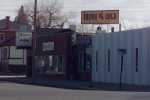
The Brown 'n Gold Outlet, on University Avenue, has a roof sign (prohibited) and too much sign area overall for the length of its storefront. Also, the projecting sign exceeds the maximum allowed area and extends too far from the building, according to the proposed ordinance.
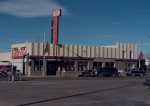
Corral West Ranchwear, on Third Street, has a roof sign (prohibited). It also has signage on a side of the building that doesn't have any street frontage. This makes sense, since it attracts customers from Third Street, but it's not allowed by the new ordinance.
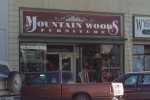
Mountain Woods Furniture, on Second Street, has a very attractive sign that fits nicely into a niche designed for that purpose by the building's architect. However, the new ordinance does not concur with the architect's sense of proportion; it says the sign is too big.
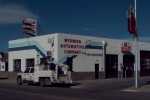
Wyoming Automotive, at 2nd and University, is lucky enough to be located on an alley, which is considered to be a "street" by the ordinance. So, its wall sign facing Third Street would be legal. The roof sign, however, would be prohibited. There are also three projecting signs visible here; only one is allowed.
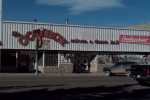
The Cowboy Saloon and Dance Hall, on Second Street, attempted to spruce up its building by adding a Western mural. However, that mural, because it's considered to be a "wall sign" under the proposed ordinance, would cause the business to exceed its maximum allowed sign area. (Even an abstract mural is considered a commercial sign if it draws attention to a business.)
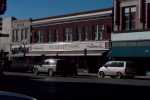
Nothing seems out of proportion about The Curiosity Shoppe's facade. In fact, it's one of downtown's prettiest storefronts -- especially during the holidays. But its sign area exceeds the legal limit under the new ordinance.
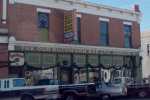
The legendary Buckhorn Bar uses up about two thirds of its allotment of sign area on the words "The Old Buckhorn Bar and Parlor," which are painted across the front above the windows. The projecting sign, the lighted one that says "Parlor Bar", and additional window signs on the first and second floors appear to put it over the limit.
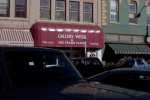
This nearly new awning sign, at Gallery West on Ivinson, looks good, but it's pushing the size limit. Depending upon how it's measured (the ordinance is vague on the proper way to do this), it could be too large.
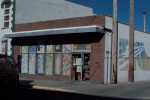
The Whole Earth Grainery, on Ivinson, always has colorful painted signs in the windows. Alas, if they're considered to be "wall signs" under the new ordinance, they will count against the total sign area limit for the business. So, when they've faded (which only takes a few months at high altitude), the new ordinance might prevent them from being replaced. There's no question, however, that the mural on the alley is out of conformance; it's too large.
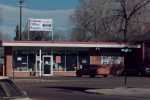
Gillette Office Supply, slightly off the beaten path at Fourth and Fremont, relies upon a roof sign (prohibited by the new code) for visibility. The new law would prohibit replacement of the sign if it blew down or was heavily damaged, and would prevent it from being reinforced to make it last longer. If the business were bought, the sign couldn't be updated to change the name.
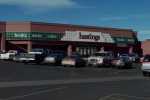
All of the stores in Gateway Plaza, on Third Street, are set far back from the roadway. They therefore require signs with large letters to be visible. Unfortunately, the proposed ordinance does not allow sign area to increase in proportion to setback. This may be why the area of Hastings' main sign, which doesn't seem outrageously large, is nonetheless far over the limit. And that's without counting the movie signs in the windows.
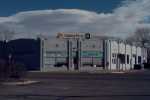
McClure Home Decorating, across the way from Gateway Plaza, is not decorated properly -- at least according to the proposed code. It has a roof sign (prohibited by the new ordinance).
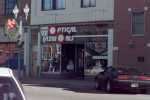
Optical Fashions of Wyoming, on Second Street, has an eye-catching sign which, like many other downtown signs, fits the niche intended for signage by the building's architect. But the new sign ordinance would deem it too large.
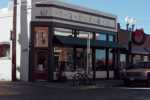
Coal Creek Coffee Company, on Grand near First Street, sports a tasteful wall sign -- with icons depicting products and fanciful spirals in between. The section of the facade in which the sign is located seems to have been intended by the architect for signage, and has historically been used this way. However, it also appears to have more area than the business is allowed for all signage under the proposed ordinance. Thus, even without the two window signs and the "Open/Closed" sign, this popular meeting place seems to be over its limit.
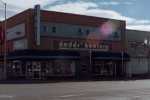
Dodds' Bootery is a local business that struggles gamely against "big box" chains KMart and Wal-Mart. Unfortunately, its Second Street signage exceeds the limits imposed by the new ordinance.
The Jaded Lair, on First Street (not shown), would not conform for the same reason. Its hand-painted sign runs the length of the storefront and is approximately three feet high. That's more than the 50 square feet allowed it by the ordinance.
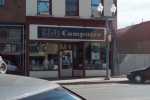
Blitz Computers' low-key sign, located on Second Street, is aesthetically pleasing, unlike the adjacent lot (which contains a barren pit more than 10 feet deep). But the sign is very close to the 50 square foot limit. (If it spanned the storefront completely, it'd be over for sure.) Add the window signs, and Blitz appears to be over its limit. The new ordinance would restrict this business, which brings in lots of mail order dollars from out of state. But it would do nothing about the visual blight next door.

At first glance, it looks as if this Third Street Subway franchise's signage conforms to the new ordinance's area limits. But Subway has "off-premise directional signs" whose areas must be deducted from its allowance of on-premise signage. This may push it over the limit. The pole sign also violates the 15 foot setback requirement in the proposed ordinance. Another franchise, Papa John's Pizza (not shown), appears to have exactly the same problems.
The ordinance allows only two off-premise directional signs per business. This limits businesses' ability to draw traffic from the highway or guide travelers to their stores.
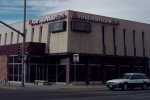
For several years, First Interstate Bank, at Third and Ivinson, sported a non-working electronic sign that said "YQFJZ" (or something similar). This sign was an embarrassment, and when First Interstate Bank came under new management it wasted no time in replacing the sign with two working ones at substantial expense. The new signs flash messages such as "Happy Thanksgiving," "Go Pokes," and "Vote Today," as well as information about Jubilee Days and other community events. Unfortunately, under the new ordinance, they would be considered "animated signs." They would have to be turned off, or limited to displaying only the time and temperature, within 60 days.
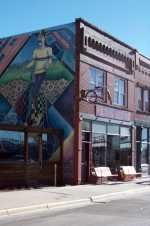
The bicycle cleverly used as a projecting sign by The Pedal House, on First Street, extends too far from the building to be legal under the new code. And because the wall sign on the side of the building (it's truly beautiful; click the picture for a closer look) does not front on a street and greatly exceeds the business's signage allotment, it would have to go too.
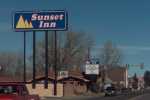
The proposed sign ordinance allows any business at most one "pole-style" sign. The Sunset Inn has three to catch the eyes of interstate travelers -- one of them the sign that shows its accreditation by the American Automobile Association. Two exceed the height limit of 20 feet.
A 20-foot height limit is problematic for businesses located near highway interchanges, because most overpasses are more than 20 feet tall. The new I-80 overpass at Snowy Range Road, for example, has a clearance -- not a total height -- of 17 feet 5 inches. Thus, a pole sign that did conform to the height limit would likely be invisible to traffic at this and other interchanges.
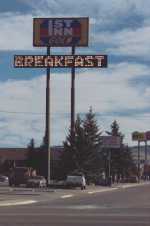
This animated sign, also called a "reader board," advertises the 1st Inn Gold (formerly the Laramie Inn) to passersby at the I-80/US 287 interchange. Under the new sign code, it would be illegal for not one but five reasons: because it is animated; because the bulbs point at the reader; because it's more than 20 feet tall; because it does not have a 15 foot setback; and because the hotel has at least one other "pole-style" sign on the premises. (Note: All of the signs in this picture, including Motel 8's, would be illegal due to insufficient setback.)
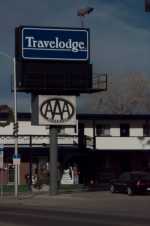
The Travelodge at Third and University is a locally owned franchise. The new owners have done a wonderful job of improving the property and refurbishing the rooms. However, they would have trouble if they wanted to leave the franchise, because their pole sign violates height and setback requirements and could not be legally changed. The value of the business would likewise be impacted if it were put up for sale. The reader board on the sign, currently turned off, could never be made operational under the new ordinance.
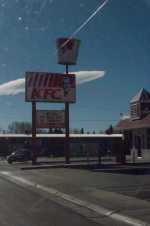
Kentucky Fried Chicken's distinctive rotating bucket, a piece of classic Americana, would have to be stopped within 60 days. Even then, the sign would still be illegal because it is too tall and has insufficient setback. And that's not all. Because the restaurant is on 21st Street, which is not a major traffic artery, it relies upon off-premise directional signs plus this "pole-style" sign to guide customers to its door. Unfortunately, the area of off-premise signs is deducted from the allowance for on-premise signs. So the restaurant, with its limited street frontage, may not be able to keep enough signage to direct customers effectively.
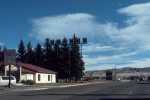
Joe Vitale, who at great expense transformed an ugly abandoned service station into a popular Italian restaurant called Vitale's, has two "pole-style" signs. The sign code implemented by the proposed ordinance would only allow one, and it would have to be no more than 20 feet tall. (His largest sign is much taller.) He would also have to stop operating an animated sign that beckons customers.
Some other Laramie establishments with pole signs that appear to violate the proposed ordinance's height and/or setback requirements include Hardee's, Mini-Mart (more than one location), Shari's, Kum & Go, The Mane Event, KMart, US Bank, The Ranger, Travel Inn, Comfort Inn, Bagelmakers, Parts America, Reed's Liquors, Crown Liquors, The Alibi, Mulligan's, Ann's Pawn Shop, The Tack Room, Foster's Country Corner, UniqueLee Ewe, C K Chuck Wagon, Holiday Inn, Motel 6, First National Bank, Laramie Lumber, and The Loyal Order Of Moose (all not shown).
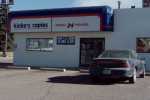
Kinko's wraparound awning, on Grand Avenue, would be deemed too large by the new code. Kinko's has street frontage, so its parking lot frontage isn't allowed any signage at all.
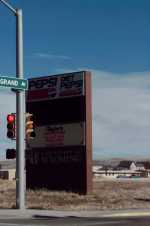
UW's animated sign on Grand Avenue once rallied fans and directed them to UW athletic events. Now unsightly because it is broken, it could never be fixed if the University obeyed the new code (which it might or might not feel obliged to do).
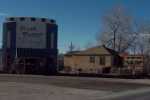
Fresh Flower Fantasy was recently voted the Chamber of Commerce's Business of the Year. But the proposed sign code would consign its main sign -- which is large so as to be seen easily from the road -- to eventual oblivion. The portable sign at the right of the picture, which directs customers to the store, would be illegal due to the flashing arrow; it would have to go within 60 days. Even if the sign were modified so it did not flash, it could only be used for two months each year -- by permit -- thereafter.
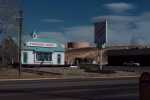
Teriyaki Bowl was formerly a Long John Silver's, but is now a locally owned and operated business that serves delicious and healthy Japanese food. Unfortunately, its signage, while it's just about the right size to draw customers without being obtrusive, would run afoul of the proposed sign code. Too much area, and the pole sign appears to be more than 20 feet tall. The nearby McDonald's and Burger King restaurants also have signs that appear to exceed the height limit.
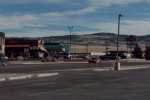
Applebee's is relatively new in town. The sign code would make this business feel welcome by making its pole sign and roof sign illegal. The pole sign would violate both height and setback requirements. The roof sign, which currently bears no copy, could not be used again.
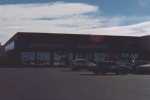
Blockbuster Video's awning sign, plus the lighted sign at the far right and other signs in the windows, appear to exceed the allowed area limits. Like Kinko's (above), Blockbuster has some street frontage, so its parking lot frontage isn't allowed any signage. But if it were, it still might be over the area limit.
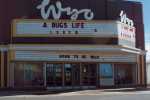
Amazingly, the new sign code contains no provision for theater marquees. The Wyo theater's classic sign has too much surface area and protrudes too far from the building to be legal under the proposed code. And the ordinance would forbid traditional theater light displays, including chasers and alternating neon lights.
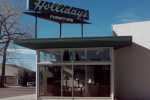
Holliday's Furniture, directly across from the Wyo, uses a roof sign as its primary sign so that it is visible from Grand Avenue. If the sign were one day damaged or blown down, it could not be replaced under the new code.
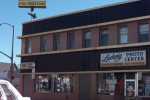
All of the outdoor signs belonging to Ludwig Photo, a family-owned downtown business managed by Anne Brande, would become non-conforming under the proposed code. Note that one is a roof sign (prohibited), while the lighted wall sign exceeds the code's area limitation. The signs inside the windows could not be changed or updated if the new code were to take effect as written.
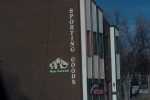
This new sporting goods store, located on Third Street, will need lots of good advertising to build a clientele because it is outside of established shopping areas. But with a wall sign on a side of the building with no street frontage, and more sign area than is allowed for its building frontage, it would be out of conformance from the start.
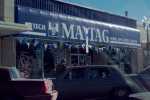
Artech Appliance, on South Second, is locked in a constant battle with Sears (Cheyenne) and other out-of-town vendors for residents' appliance dollars. This impressive awning sign was obviously expensive to install. However, it is far over the size limit set by the ordinance.
All Terrain Sports, on Grand (not shown), appears to be in the same situation.
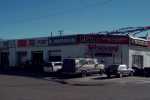
Plains Tire, on South Second, keeps dollars in Laramie's local economy by offering aggressive prices to local customers. Its vendor signs consume too much area to conform to the new code.

A&C Feed, in West Laramie, has a sign on the side of its quonset hut for visibility from Snowy Range Road. This sign would not be allowed by the ordinance because it does not front on a street. The signage for this business also exceeds area limitations.
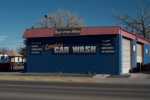
The Cowboy Car Wash, on North Third, has informative and attractive signage -- but too much, alas, to conform to the proposed code. Competitor Robo-Wash, on South Third (not shown), has two pole signs (the limit is one), both of which are non-conforming.
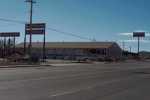
A to Z Tire, on Snowy Range Road, has three pole signs bearing the names of tire vendors. Only one is allowed by the ordinance. There appear to be problems with height restrictions as well.

According to the new code, Westbrook's Pawn Shop would have too much sign area. When the building was next painted, informative writing would have to be replaced by an expanse of blank cement wall.
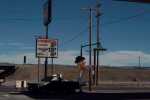
This gunslinger may be headed for his last showdown. He's a pole sign, son -- and the Gunslinger 66 station, at the Snowy Range Road interchange, already has another. (That sign, at the left of the picture, appears to violate the new setback requirement.) So, the Law might say this pardner has ta git outta town (though he would be "grandfathered" for a spell).
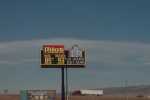
This large sign, owned by the Pilot truck stop, was damaged by wind and is being repaired. If it were heavily damaged again after the ordinance was passed, it might not be legal to repair it, making it an embarrassing eyesore. Nor could Pilot change the sign if, for example, there was no longer a Wendy's restaurant there.
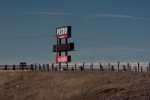
Petro's reader board, at the Curtis Street interchange, would go dark if the proposed ordinance passed. The sign would be doomed by all of the same rules that would make 1st Inn Gold's sign illegal (see above).
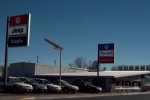
Kotby Motors, on North Third Street, has three pole signs (only one is allowed) and a roof sign (prohibited). All of the pole signs violate the setback requirement in the proposed ordinance.
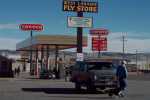
The West Laramie Fly Store, on Snowy Range Road, is also a Conoco station and has a total of three pole signs. The ordinance allows only one. At least two of the signs appear not to meet the new code's setback requirement.
The majority of service stations in town -- including Knight Oil's recently acquired "Quick and Easy" property at Fourth and University (not shown) -- face similar problems. And Knight Oil's video rental sign, which has chaser lights, would have to be modified or removed within 60 days.
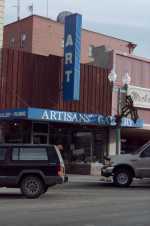
The Artisans' Gallery, on Second Street, appears to have more sign area than the new ordinance would allow.

This off-premise directional sign, in West Laramie, is shared by the tenants of Northridge Center. Unfortunately, it's a billboard, which means it couldn't be rebuilt to extend its useful life. Since each business would be limited to two off-premise directional signs, it could not place a sign at each entrance to the city. What's more, each would have to deduct the area of its portion of this sign from its on-premise sign allowance. Under the ordinance, off-premise directional signs can't contain phone numbers, so travelers can't call ahead with food orders or to ask for directions.
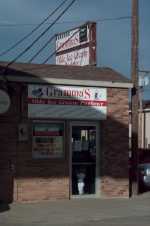
Gramma's Olde Ice Cream Parlour beckons travelers enroute to and from the Snowy Range and has a loyal following of local customers. But it has too much signage for its street frontage, according to the proposed ordinance. It also has a prohibited roof sign.